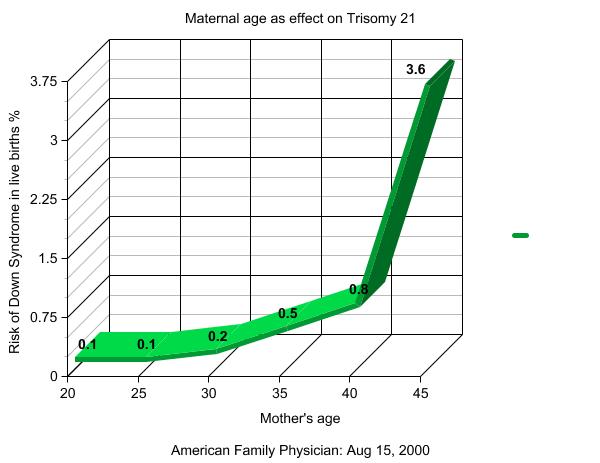Down syndrome epidemiology and demographics: Difference between revisions
No edit summary |
No edit summary |
||
| Line 11: | Line 11: | ||
[[Maternal age effect|Maternal age]] influences the chances of conceiving a baby with Down syndrome. At maternal age 20 to 24, the probability is 1/1490; at age 40 the probability is 1/60, and at age 49 the probability is 1/11.<ref name=Hook>{{cite journal|author = Hook, E.B.|year = 1981|title = Rates of chromosomal abnormalities at different maternal ages|journal = Obstet Gynecol|volume = 58|pages = 282}} PMID 6455611</ref> Although the probability increases with maternal age, 80% of children with Down syndrome are born to women under the age of 35,<ref>Estimate from {{cite web |title=National Down Syndrome Center |url=http://www.ndsccenter.org/resources/package3.php |accessdate = 2006-04-21}}</ref> reflecting the overall fertility of that age group. Recent data also suggest that paternal age also increases the risk of Down Syndrome manifesting in pregnancies in older mothers.<ref>Warner, Jennifer. "Dad's Age Raises Down Syndrome Risk, Too", {{cite web |title=WebMD Medical News |url=http://www.webmd.com/infertility-and-reproduction/news/20030701/dad-age-down-syndrome |accessdate= 2007-09-29}}</ref> | [[Maternal age effect|Maternal age]] influences the chances of conceiving a baby with Down syndrome. At maternal age 20 to 24, the probability is 1/1490; at age 40 the probability is 1/60, and at age 49 the probability is 1/11.<ref name=Hook>{{cite journal|author = Hook, E.B.|year = 1981|title = Rates of chromosomal abnormalities at different maternal ages|journal = Obstet Gynecol|volume = 58|pages = 282}} PMID 6455611</ref> Although the probability increases with maternal age, 80% of children with Down syndrome are born to women under the age of 35,<ref>Estimate from {{cite web |title=National Down Syndrome Center |url=http://www.ndsccenter.org/resources/package3.php |accessdate = 2006-04-21}}</ref> reflecting the overall fertility of that age group. Recent data also suggest that paternal age also increases the risk of Down Syndrome manifesting in pregnancies in older mothers.<ref>Warner, Jennifer. "Dad's Age Raises Down Syndrome Risk, Too", {{cite web |title=WebMD Medical News |url=http://www.webmd.com/infertility-and-reproduction/news/20030701/dad-age-down-syndrome |accessdate= 2007-09-29}}</ref> | ||
==References== | ==References== | ||
Revision as of 16:57, 24 August 2012
|
Down syndrome Microchapters |
|
Diagnosis |
|---|
|
Treatment |
|
Case Studies |
|
Down syndrome epidemiology and demographics On the Web |
|
American Roentgen Ray Society Images of Down syndrome epidemiology and demographics |
|
Risk calculators and risk factors for Down syndrome epidemiology and demographics |
Editor-In-Chief: C. Michael Gibson, M.S., M.D. [1]
Overview
Epidemiology and Demographics

The incidence of Down syndrome is estimated at 1 per 800 to 1 per 1000 births.[1] In 2006, the Center for Disease Control estimated the rate as 1 per 733 live births in the United States (5429 new cases per year).[2] Approximately 95% of these are trisomy 21. Down syndrome occurs in all ethnic groups and among all economic classes.
Maternal age influences the chances of conceiving a baby with Down syndrome. At maternal age 20 to 24, the probability is 1/1490; at age 40 the probability is 1/60, and at age 49 the probability is 1/11.[3] Although the probability increases with maternal age, 80% of children with Down syndrome are born to women under the age of 35,[4] reflecting the overall fertility of that age group. Recent data also suggest that paternal age also increases the risk of Down Syndrome manifesting in pregnancies in older mothers.[5]
References
- ↑ Based on estimates by National Institute of Child Health & Human Development "Down syndrome rates". Retrieved 2006-06-21.
- ↑ Center for Disease Control (6 January 2006). "Improved National Prevalence Estimates for 18 Selected Major Birth Defects, United States, 1999–2001". Morbidity and Mortality Weekly Report. 54 (51 & 52): 1301–1305. Check date values in:
|date=(help) - ↑ Hook, E.B. (1981). "Rates of chromosomal abnormalities at different maternal ages". Obstet Gynecol. 58: 282. PMID 6455611
- ↑ Estimate from "National Down Syndrome Center". Retrieved 2006-04-21.
- ↑ Warner, Jennifer. "Dad's Age Raises Down Syndrome Risk, Too", "WebMD Medical News". Retrieved 2007-09-29.